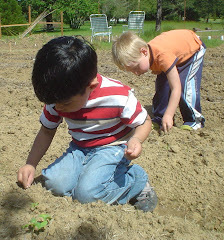(To read a compilation of all our potato blogs, go to:
Can I plant potatoes from the grocery store? and
Why grow your own potatoes when they're still relatively cheap at the grocery store? Well for one thing, potatoes are one of those vegies that are good to eat organic and buying them organic can be expensive. Also, they're fun to grow. This article will tell you how you can turn that scary tangle of sprouting potatoes under your sink, into a meal (or ten!) next fall.Can I plant potatoes from the grocery store? and
Buying seed potatoes from a nursery catalog can be pretty pricey and its not really necessary. The only real advantage is that they sort them for uniformity of size (not a big deal) and you can find some exotic varieties. We just use ones we saved from last year's harvest or buy them straight out of the produce section at the grocery store. Any potato, with sprouting eyes, that's at least the size of a chicken egg has the means to yield up to five pounds of fresh potatoes. This is a good time of year to buy seed potatoes from the grocery store. Many of the potatoes that have been in storage for the winter are starting to sprout in the warehouses and you can get them for great prices. Look for a bag that already has a lot of "buds" on the eyes since non-organic potatoes are sprayed with a "sprout-deterrent" and they just might not ever sprout. Choose the variety you like best. Potatoes do not "cross pollinate". This means that, if you plant a russet, by golly you'll get a russet. (Note: one of our favorites is the Yukon Gold. They last a long time in winter storage and we like the flavor/texture too.)
If the potatoes you have are only just starting to sprout and the buds aren't very long, keep them in the dark to encourage more sprouting. Once the buds are at least 3/4 of an inch long, it's time to "chit" them.
Chitting is a way to help the potatoes store up the sun's energy. This gives them a head start which makes them more likely to produce a big crop. Take the potatoes and put them in indirect sunlight. They will start to turn a little green. Also, the sprouts will 'harden off' making them less likely to get damaged when you plant them.
These are a good size for planting. Note the greenish hue from "chitting".
You can chit potatoes in your house near a window, or on a covered porch, or in a greenhouse. Don't put them in direct sunlight and, if there's danger of frost, cover them with a towel or cloth at night or bring them inside.
This large potato was cut and allowed to dry on the exposed side before planting.
After they have "greened up' a bit, and any cut parts have sealed over, they are ready to plant. Green potatoes are poisonous so don't eat them after chitting.Here are potatoes on a covered porch where they get indirect light.
If you have chitted your potatoes and its still too early to plant (the ground is too soggy or there's still snow on the ground) you can store them in a cardboard box or plastic tub, layered between leaves from last fall. You can also use straw.
How many potatoes should you plant? Depending on the variety, you can get five or more pounds of potatoes for each one you plant. You'll need about a foot between each plant in your garden and potatoes like lots of sun and loose, sandy soil. Here in the Sharing Gardens we plant hundreds of feet of potatoes as they're a good storage crop and keep feeding people well into the winter.Chitted potatoes, too early to plant, stored in layers in a tub with leaves.
If you live locally and all this is more than you want to take on right now, and you have sprouting potatoes you want to contribute, just let us know and we'll arrange to get them from you. We'll chit them and plant them in the sharing garden and you can share in the harvest.Some of our 2009 harvest, with seed potatoes stored in a paper sack (on the right).
Llyn and Chris
AlpineCoGarden@gmail.com
(541) 847-8797










































Here is a follow-up to give more info to those who wish to grow "exotic" potatoes. Llyn
ReplyDeletePotatoes are unique in that their growth cycle is not determined by length of day (as so many other plants are.) Potatoes have an internal clock that requires them to be dormant for a prescribed amount of time--different lengths for different varieties of potatoes. You can't rush this cycle. They won't sprout until their dormancy cycle has been reached. This is why some potatoes are better storage potatoes, because they won't start sprouting before you've eaten all the ones you want to eat.
The exotic potatoes that are in the markets now (spring) are probably quite fresh, and shipped in from South America. If so, they likely won't be ready for chitting and planting till late summer or early fall. But don't despair or give up. I want to encourage you still to follow your inspiration and get some potatoes in the ground this spring - even if they're just boring yukon golds, or red potatoes . This will give you a successful experience and then in the fall you can buy the exotic varieties that are arriving to market fresh then. Hold those in storage through the winter and next spring you can start a batch of exotics and be in the right rhythm to grow them out in your locales.
Remember: when selecting potatoes to plant, look for ones that already show signs of budding/sprouting from the eyes. Then follow the rest of the instructions in the article and you're "bound to be successful!"
Thank you so much for this article!! I'm very excited to start growing my own potatoes!
Delete